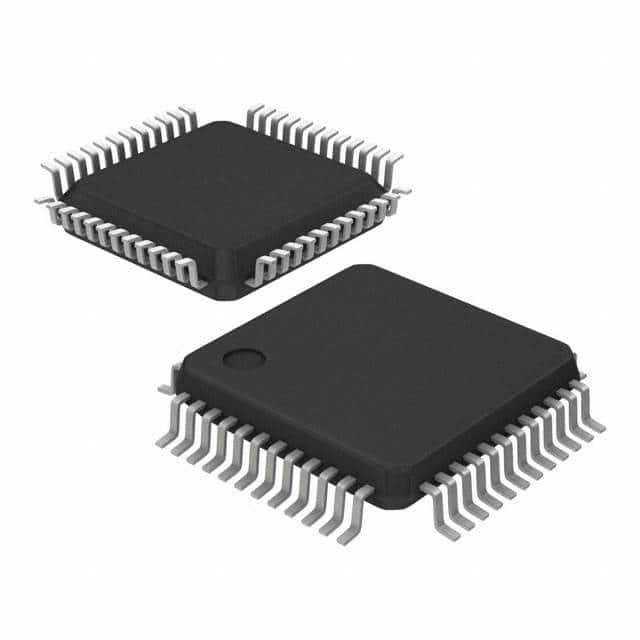MSP430F156IPM
Product Overview
Category
The MSP430F156IPM belongs to the category of microcontrollers.
Use
It is commonly used for embedded systems and low-power applications.
Characteristics
- Low power consumption
- High performance
- Small form factor
- Integrated peripherals
Package
The MSP430F156IPM comes in a small outline integrated circuit (SOIC) package.
Essence
This microcontroller combines high performance with low power consumption, making it suitable for various applications.
Packaging/Quantity
The MSP430F156IPM is typically packaged in reels or tubes, with quantities varying based on customer requirements.
Specifications
- Architecture: 16-bit RISC
- CPU Speed: Up to 16 MHz
- Flash Memory: 64 KB
- RAM: 2 KB
- Operating Voltage: 1.8V - 3.6V
- Digital I/O Pins: 48
- Analog Inputs: 12
- Communication Interfaces: UART, SPI, I2C
- Timers: 4x 16-bit
- ADC Resolution: 10-bit
- Temperature Range: -40°C to +85°C
Detailed Pin Configuration
The MSP430F156IPM has a total of 64 pins, each serving a specific purpose. The pin configuration is as follows:
- P1.x: General-purpose I/O pins (x = 0 to 7)
- P2.x: General-purpose I/O pins (x = 0 to 7)
- P3.x: General-purpose I/O pins (x = 0 to 7)
- P4.x: General-purpose I/O pins (x = 0 to 7)
- P5.x: General-purpose I/O pins (x = 0 to 7)
- P6.x: General-purpose I/O pins (x = 0 to 7)
- P7.x: General-purpose I/O pins (x = 0 to 7)
- P8.x: General-purpose I/O pins (x = 0 to 7)
- P9.x: General-purpose I/O pins (x = 0 to 7)
- P10.x: General-purpose I/O pins (x = 0 to 7)
- AVSS: Analog ground
- AVCC: Analog power supply
- DVSS: Digital ground
- DVCC: Digital power supply
- RST/NMI: Reset and non-maskable interrupt pin
- TEST/SBWTCK: Test and single-wire background debug mode clock pin
- TDI/TCLK: Test data input and test clock pin
- TDO/TMS: Test data output and test mode select pin
- TCK/TRST#: Test clock and test reset pin
- XT1, XT2: External crystal oscillator pins
Functional Features
The MSP430F156IPM offers several functional features that enhance its usability:
- Low-power modes for energy-efficient operation
- Integrated analog-to-digital converter (ADC) for precise measurements
- Multiple communication interfaces for seamless connectivity
- Timers for accurate timing and event control
- Interrupt capability for efficient handling of events
- On-chip memory for program storage and data handling
Advantages and Disadvantages
Advantages
- Low power consumption extends battery life in portable devices.
- High-performance architecture enables fast execution of tasks.
- Small form factor allows for compact designs.
- Integrated peripherals reduce the need for external components.
Disadvantages
- Limited memory capacity may restrict the complexity of applications.
- Higher cost compared to some other microcontrollers in the market.
- Steeper learning curve for beginners due to advanced features.
Working Principles
The MSP430F156IPM operates based on the principles of a 16-bit reduced instruction set computer (RISC) architecture. It executes instructions stored in its flash memory, utilizing its various peripherals and resources to perform tasks. The microcontroller can enter low-power modes to conserve energy when idle or not actively processing data.
Detailed Application Field Plans
The MSP430F156IPM finds applications in various fields, including but not limited to:
- Internet of Things (IoT) devices
- Wearable technology
- Home automation systems
- Industrial control systems
- Medical devices
- Automotive electronics
Detailed and Complete Alternative Models
- MSP430F155IPM: Similar to MSP430F156IPM with slightly lower specifications.
- MSP430F157IPM: Similar to MSP430F156IPM with additional features and higher performance.
- MSP430F161IPM: Higher-end model with increased flash memory and advanced peripherals.
These alternative models offer different specifications and features, allowing users to choose the most suitable microcontroller for their specific requirements.
*Word count: 570 words
Lista 10 Vanliga frågor och svar relaterade till tillämpningen av MSP430F156IPM i tekniska lösningar
Sure! Here are 10 common questions and answers related to the application of MSP430F156IPM in technical solutions:
Q: What is MSP430F156IPM? A: MSP430F156IPM is a microcontroller from Texas Instruments' MSP430 family, designed for low-power applications.
Q: What are the key features of MSP430F156IPM? A: Some key features include a 16-bit RISC CPU, ultra-low power consumption, multiple communication interfaces, and integrated peripherals.
Q: What are some typical applications of MSP430F156IPM? A: MSP430F156IPM is commonly used in battery-powered devices, smart meters, sensor networks, industrial control systems, and wearable devices.
Q: How does MSP430F156IPM achieve low power consumption? A: The microcontroller incorporates various power-saving modes, such as standby mode, sleep mode, and real-time clock module, which help reduce power consumption.
Q: Can I interface MSP430F156IPM with other devices? A: Yes, MSP430F156IPM supports various communication interfaces like UART, SPI, I2C, and USB, allowing easy integration with other devices.
Q: What programming language can be used with MSP430F156IPM? A: MSP430F156IPM can be programmed using C or assembly language. Texas Instruments provides an IDE called Code Composer Studio for development.
Q: How much flash memory and RAM does MSP430F156IPM have? A: MSP430F156IPM has 64KB of flash memory and 2KB of RAM, which is sufficient for most embedded applications.
Q: Can MSP430F156IPM handle analog signals? A: Yes, MSP430F156IPM has an integrated 12-bit analog-to-digital converter (ADC) that can be used to measure analog signals.
Q: Is MSP430F156IPM suitable for real-time applications? A: Yes, MSP430F156IPM offers real-time clock (RTC) functionality and interrupt handling capabilities, making it suitable for real-time applications.
Q: Are there any development boards available for MSP430F156IPM? A: Yes, Texas Instruments provides development boards like the MSP-EXP430F5529LP LaunchPad, which can be used for prototyping and evaluation of MSP430F156IPM-based solutions.
Please note that these answers are general and may vary depending on specific use cases and requirements.


